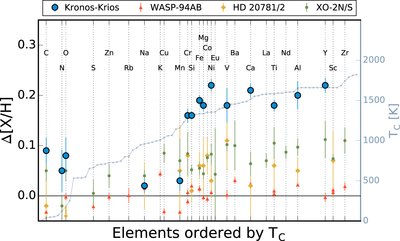Image Details

Caption: Figure 8.
Abundance differences of the Kronos–Krios pair ranked by the condensation temperature of elements for solar-composition gas from Lodders (2003). The condensation temperature may be read from the gray line and right y-axis. We show three wide binary systems selected from the literature: HD 20782/1 (Mack et al. 2014, ﹩[\mathrm{Fe}/{\rm{H}}]\approx 0﹩), XO-2N/S (Biazzo et al. 2015, ﹩[\mathrm{Fe}/{\rm{H}}]\approx 0.35﹩), and WASP-94AB (Teske et al. 2016a, ﹩[\mathrm{Fe}/{\rm{H}}]\approx 0.3﹩). Locations of elements with at least one measurement from any study are indicated by a vertical line and its symbol. Note that multiple values are often reported for one element, which corresponds to different ionization states in equivalent width analyses. No other pair studied so far was shown to have such a large difference in metallicity or sharp contrast between (moderately) volatile and refractory elements as Kronos–Krios.
Copyright and Terms & Conditions
© 2018. The American Astronomical Society. All rights reserved.











